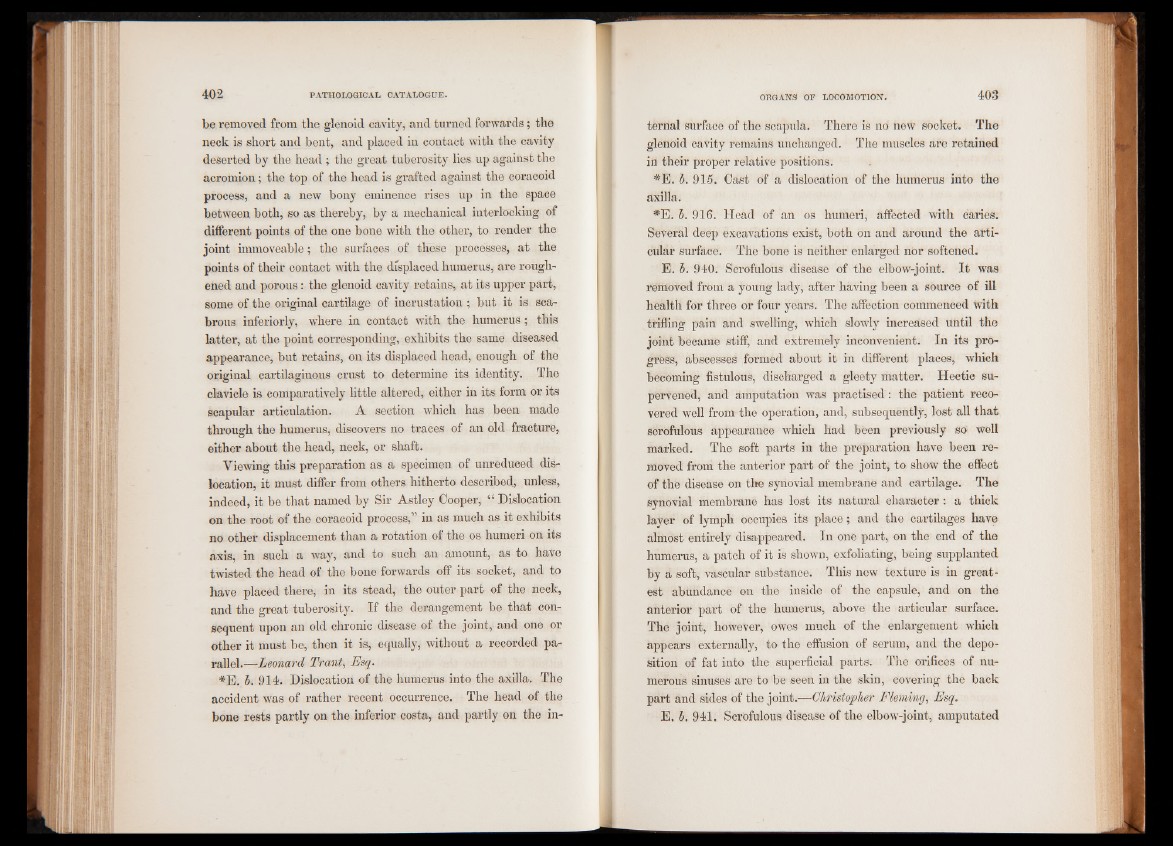
be removed from the glenoid cavity, and turned forwards; the
neck is short and bent, and placed in contact with the cavity
deserted by the head; the great tuberosity lies up against the
acromion; the top of the head is grafted against the coracoid
process, and a new bony eminence rises up in the space
between both, so as thereby, by a mechanical interlocking of
different points of the one bone with the other, to render the
joint immoveable; the surfaces of these processes, at the
points of their contact with the dfsplaced humerus, are roughened
and porous: the glenoid cavity retains, at its upper part,
some of the original cartilage of incrustation ; but it is scabrous
interiorly, where in contact with the humerus; this
latter, at the point corresponding, exhibits the same diseased
appearance, but retains, on its displaced head, enough of the
original cartilaginous crust to determine its identity. The
clavicle is comparatively little altered, either in its form or its
scapular articulation. A section which has been made
through the humerus, discovers no traces of an old fracture,
either about the head, neck, or shaft.
Viewing this preparation as a specimen of unreduced dislocation,
it must differ from others hitherto described., unless,
indeed, it be that named by Sir Astley Cooper, “ Dislocation
on the root of the coracoid process,1’ in as much as it exhibits
no other displacement than a rotation of the os humeri on its
axis, in such a way, and to such an amount, as to hate
twisted the head of the bone forwards off its socket, and to
have placed there, in its stead, the outer part of the neck,
and the great tuberosity. If the derangement be that consequent
upon an old chronic disease of the joint, and one or
other it must be, then it is, equally* without a recorded parallel.—
Leonard Trant, Esq.
#E. b. 914. Dislocation of the humerus into the axilla. The
accident was of rather recent occurrence. The head of the
bone rests partly on the inferior costa, and partly on the interrial
surface of the scapula. There is no new socket. The
glenoid cavity remains unchanged. The muscles are retained
in their proper relative positions.
*E. b. 915. Oast of a dislocation of the humerus into the
axilla.
#E. b. 916. Head of an os humeri, affected with caries.
Several deep excavations exist, both on and around the articular
surface. The bone is neither enlarged nor softened.
E. b. 940. Scrofulous disease of the elbow-joint. It was
removed from a young lady, after having been a source of ill
health for three or four years. The affection commenced with
trifling pain and swelling, which slowly increased until the
joint became stiff, and extremely inconvenient. In its progress,
abscesses formed about it in different places, which
becoming fistulous, discharged a gleety matter. Hectic supervened,
and amputation was practised: the patient recovered
well from the operation, and, subsequently, lost all that
scrofulous appearance which had been previously so well
marked. The soft parts in the preparation have been removed
from the anterior part of the joint, to show the effect
of the disease on the synovial membrane and cartilage. The
synovial membrane has lost its natural character: a thick
layer of lymph occupies its place; and the cartilages have
almost entirely disappeared. In one part, on the end of the
humerus, a patch of it is shown, exfoliating, being supplanted
by a soft, vascular substance. This new texture is in greatest
abundance on the inside of the capsule, and on the
anterior part of the humerus, above the articular surface.
The joint, however, owes much of the enlargement which
appears externally, to the effusion of serum, and the deposition
of fat into the superficial parts. The orifices of numerous
sinuses are to be seen in the skin, covering the back
part and sides of the joint.—Christopher Fleming, Esq.
E. b. 941. Scrofulous disease of the elbow-joint, amputated